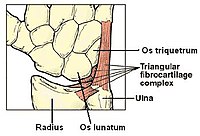
Photo from wikipedia
Background: Tendon-related complications after plate fixation of distal radius fractures can cause significant morbidity in the patient. This retrospective systematic review aims to report and compare the current rate of… Click to show full abstract
Background: Tendon-related complications after plate fixation of distal radius fractures can cause significant morbidity in the patient. This retrospective systematic review aims to report and compare the current rate of tendon rupture and tenosynovitis complicating the operative management of distal radius fractures. Methods: A systematic literature search was performed to identify relevant articles reporting tendon complications after operative management of distal radius fractures. The search included published articles in three electronic databases—Ovid MEDLINE, EMBASE, and the Cochrane Library—starting from the establishment of each database to February of 2016. Results: A total of 56 studies met the inclusion criteria, including 6278 patients. Overall tendon-related adverse events were reported in 420 patients (6.8 percent). The incidence of tendon rupture was 1.5 percent with volar plates and 1.7 percent with dorsal plates. The incidence of tenosynovitis was 4.5 percent with volar plates and 7.5 percent with dorsal plates. Individual tendon complications were reported with volar and dorsal fixation, respectively: extensor pollicis longus tenosynovitis (0.3 percent and 1.1 percent), extensor pollicis longus rupture (0.8 percent and 0.3 percent), flexor pollicis longus tenosynovitis (1.3 percent and 0 percent), flexor pollicis longus rupture (0.6 percent and 0.2 percent), flexor digitorum profundus/flexor digitorum superficialis tenosynovitis (1.2 percent and 1.3 percent), flexor digitorum profundus/flexor digitorum superficialis rupture (0.1 percent and 0 percent), extensor digitorum communis tenosynovitis (1.7 percent and 5.9 percent), and extensor digitorum communis rupture (0.05 percent and 1.3 percent). Conclusion: This systematic review provides an update on the literature regarding tendon-related complications in the management of distal radius fractures.
Journal Title: Plastic and Reconstructive Surgery
Year Published: 2017
Link to full text (if available)
Share on Social Media: Sign Up to like & get
recommendations!